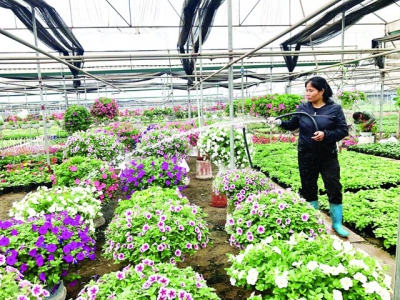Hanoi plans for flowers, ornamental plants to grow into spearhead sector

The capital city of Hanoi has asked districts and communes to plan for flowers and ornamental plants to become a key sector of the capital’s economic development and environmental improvement.
High-tech application for moth orchid growing in Dan Phuong District’s Dan Hoai Cooperative
Inadequacies
Hanoi’s cultivation area of flowers and ornamental plants increased from 5,484ha in 2015 to 7,960ha in 2020, mainly in the districts of Bac Tu Liem, Me Linh, Tay Ho, Dan Phuong and Thuong Tin. Thanks to new and highly-productivity seedlings, advanced fertilization procedures, mineral nutrition and automatically adjusted light and temperature systems, the yield of flowers and ornamental plants in the city is continuously increasing, with the average production value reaching VND0.5-1.5 billion per hectare per year.
Among the 313 recognized traditional craft villages, 11 specialize in cultivation of flowers and ornamental plants, among them Co Giao, Xam Xuyen, Tay Tuu, Tam Xa, Nhat Tan and Tu Lien.
Although positive initial results have been achieved, the development of flowers and ornamental plants in Hanoi still experiences shortcomings. Specifically, policies to support the development of flowers and ornamental plants are available but implementing them has proven difficult.
Policies on high-tech application have not been implemented, while support for growers is lacking. In addition, planning is lacking for areas specializing in growing flowers and ornamental plants.
Practical actions
Governmental Decree 52/2018/ND-CP on the development of rural trade officially recognizes the production and trading of flowers and ornamental plants. On March 17, 2021, the Hanoi Party Committee issued Program 04 on enhancing the effective implementation of the national target program on new-style rural area building associated with agricultural restructuring and economic development for better living standards in rural areas for the 2021-2025 period.
Nguyen Van Chi, deputy head of the Hanoi Coordination Office on New Rural Development, suggested the Ministry of Agriculture and Rural Development in coordination with provinces and cities review relevant policies in order to resolve bottlenecks. In addition, departments and district-level people’s committees should improve planning and resource allocation to develop flowers and ornamental plants into a spearhead economic sector, serving the capital’s economic development and environmental improvement.
Professional associations should work with state management agencies to appraise product prices and attach codes of growing areas and traceability. In addition, setting up digital maps of flowers and ornamental plants for information transparency and for the management and supervision is essential.
Nguyen Van Chi, deputy head of the Hanoi Coordination Office on New Rural Development, said the development of flower and ornamental plant production in the city not only creates more jobs for local farmers, but also contributes significantly to the growth of the local agricultural sector.
Có thể bạn quan tâm
 20,000 tonnes of lychee exported to Japan
20,000 tonnes of lychee exported to Japan A ceremony took place in the northern province of Bắc Giang’s Tân Yên District on Wednesday to mark the export of 20,000 tonnes of thiều lychees to Japan.
 Lychee farmers learn the ropes of online trading
Lychee farmers learn the ropes of online trading While the pandemic has ushered in online trading of agricultural produce, lychees farmers who lack the tech savvy are finding it a difficult process.
 Commodity-oriented rice production - an effective direction of Huong Trang Cooperative
Commodity-oriented rice production - an effective direction of Huong Trang Cooperative Huong Trang Cooperative was established in June 2015, it has gradually affirmed the effectiveness and cohesion between the cooperative